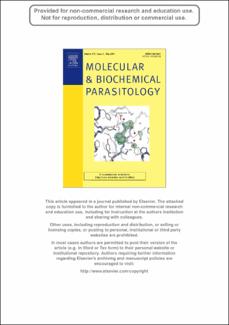Mostrar el registro sencillo del ítem
Plasmodium falciparum field isolates use complement receptor 1 (CR1) as a receptor for invasion of erythrocytes
| dc.contributor.author | Awandarea, Gordon A. | |
| dc.contributor.author | Spadafora, Carmenza | |
| dc.contributor.author | Mocha, J. Kathleen | |
| dc.contributor.author | Duttaa, Sheetij | |
| dc.contributor.author | Haynesa, J. David | |
| dc.contributor.author | Stoutea, José A. | |
| dc.date.accessioned | 2020-06-13T20:11:06Z | |
| dc.date.available | 2020-06-13T20:11:06Z | |
| dc.date.issued | 2011-05-18 | |
| dc.identifier.other | https://www.ncbi.nlm.nih.gov/pmc/articles/PMC3070236/ | |
| dc.identifier.uri | http://repositorio-indicasat.org.pa/handle/123456789/60 | |
| dc.description | AmajorityofPlasmodiumfalciparumstrainsinvadeerythrocytesthroughinteractionswithsialicacid(SA) on glycophorins. However, we recently reported that complement receptor 1 (CR1) is a SA-independent invasionreceptorofmanylaboratorystrainsofP.falciparum.TodeterminetheroleofCR1inerythrocyte invasion among P. falciparum field isolates, we tested eight isolates obtained from children in Kenya. All the parasites examined were capable of invading in a SA-independent manner, and invasion of neuraminidase-treatederythrocyteswasnearlycompletelyblockedbyanti-CR1andsolubleCR1(sCR1). Inaddition,anti-CR1andsCR1partiallyinhibitedinvasionofintacterythrocytesinamajorityofisolates tested. Sequencing of the hypervariable region of P. falciparum AMA-1 showed considerable diversity among all the isolates. These data demonstrate that CR1 mediates SA-independent erythrocyte invasion in P. falciparum field isolates. | en_US |
| dc.description.abstract | AmajorityofPlasmodiumfalciparumstrainsinvadeerythrocytesthroughinteractionswithsialicacid(SA) on glycophorins. However, we recently reported that complement receptor 1 (CR1) is a SA-independent invasionreceptorofmanylaboratorystrainsofP.falciparum.TodeterminetheroleofCR1inerythrocyte invasion among P. falciparum field isolates, we tested eight isolates obtained from children in Kenya. All the parasites examined were capable of invading in a SA-independent manner, and invasion of neuraminidase-treatederythrocyteswasnearlycompletelyblockedbyanti-CR1andsolubleCR1(sCR1). Inaddition,anti-CR1andsCR1partiallyinhibitedinvasionofintacterythrocytesinamajorityofisolates tested. Sequencing of the hypervariable region of P. falciparum AMA-1 showed considerable diversity among all the isolates. These data demonstrate that CR1 mediates SA-independent erythrocyte invasion in P. falciparum field isolates. | en_US |
| dc.language.iso | eng | en_US |
| dc.rights | https://creativecommons.org/licenses/by-nc-sa/4.0/ | |
| dc.rights | info:eu-repo/semantics/openAccess | |
| dc.subject | Malaria | en_US |
| dc.subject | CR1 | en_US |
| dc.subject | Red Cell | en_US |
| dc.subject | Invasion | en_US |
| dc.subject | Sialic acid | en_US |
| dc.title | Plasmodium falciparum field isolates use complement receptor 1 (CR1) as a receptor for invasion of erythrocytes | en_US |
| dc.type | info:eu-repo/semantics/article | en_US |
| dc.type | info:eu-repo/semantics/publishedVersion |

